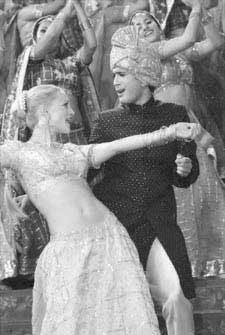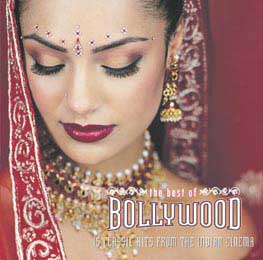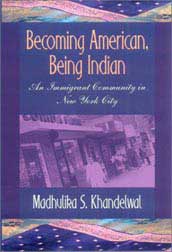Magazine
InMerica

Our roving reports.
|
FACE TO FACE WITH M.F.HUSAIN
He’s the white-maned icon who likes to go barefoot even in swanky restaurants. His paintings fetch huge sums and heat up things at Sotheby’s and Christies. Last December, an NRI bought his painting titled Lightning for $450,000 in Bombay. M.F. Husain started out in life as an unknown street painter, painting cinema hoardings in Bombay to eke out a living and went on to become the toast of the art world. He also turned filmmaker with Gajgamini, starring his muse Madhuri Dixit and has now made a second film, this time with Tabu. At 84, the celebrated artist is full of surprises, with many more canvases still to paint. Which of your paintings is considered the most valuable? To the one who buys it, to him that is the most valuable painting. That way, I think I must have painted hundreds of valuable paintings. Who are the people who are buying your art in the West? Talking about film, how did you decide to turn filmmaker? Since making Gajgamani, which stars Madhuri Dixit, you have made another film with Tabu. When do we get to see these in the U.S.? Is there anything that you’ve left undone and would still like to attempt? Do you ever feel you’ve got to leave a legacy? Do you still like to go barefoot? What gives you the most pleasure still? You convey India in a wonderful way in your paintings and it’s always in your thoughts, isn’t it? Always. I have never painted anything else. We have 5000 years of culture, so much material we have. If you were to ever leave India, if you were to be exiled, would you be able to survive it? That would be difficult – maybe I would die soon! JIMI GOES HOME
Jimi Mistry, the hot new star of the romantic comedy, The Guru, was born in Yorkshire, England. The son of an Indian doctor and an Irish nurse, he grew up in Manchester and spent time in Wales and in London. He visited India for the first time when he went location shooting for the movie recently. So how does he relate to a Motherland he hardly knows? “My dad came over to England when he was six with most of his family. He had a real struggle to make something of himself, which he’s done. He made a decision he’d be very open-minded and very liberal about the way that we were brought up. I became a Catholic through my mother, but that’s not to say I didn’t have the same exposure to the Indian side of my family because we did everything: we went to every wedding that was going on, we celebrated Diwali, but it just wasn’t my everyday life. I was a Michael Jackson wanna be, I was this, I was that. “I didn’t have much opportunity to go to India, that’s why it was such a shock to me when I went there. If I were going there for a vacation or to visit family, it would still have been a lot. But going there as an actor! The only actor trying to learn to ride a moped in the streets of Old Delhi with people going, “Hero! Hero!” I didn’t know what to say! “But seriously, it’s amazing when you get this feeling of affinity, of feeling very close but you also feel very distant, because you’ve not been brought up within that.” BY GOLLY -IT’S BOLLYWOOD!
The Bollywood bug seems to have bitten Amreeka hard! Earlier, all you saw of India was the plight of the Bengal tiger on Discovery channel or documentaries on public television. Now bawdy, saucy Bollywood is really getting some respect – and it’s about time with the Bombay film industry churning out 1,000 feature films every year. This month TV viewers in the United States will get to see not one, not two but a full dozen of the best of Hindi films in a film festival dedicated to Bollywood on Turner Classic Movies. Director-producer Ismail Merchant will co-host in the festival each Thursday in June. This wonderful mix of films includes tragedies, melodramas and romances from the early 50’s right up to the present. Says Merchant, “Bollywood has added a new dimension to entertainment audiences all over the world. It is full of energy and charge, and the TCM move to show these selected films is a great opportunity for viewers to tune into Bollywood.” Film buffs will be delighted to know that the festival includes such classics as Raj Kapoor’s Awaara, Bimal Roy’s Do Bigha Zameen, Mehboob Khan’s Mother India, Guru Dutt’s Pyaasa, Kamal Amrohi’s Pakeeza and the action-packed all-time favorite Sholay. There’s also that big fun film, Amar Akbar Anthony besides current hits like Dilwale Dulhania Le Jayenge, Bombay and Rangeela. Since Turner Classic Movies is currently seen in 63.4 million homes on the 24-hour cable network from Turner Broadcasting system, we’ll soon have many more Bollywood addicts. So bring out the popcorn and samosas and enjoy! BOLLYWOOD GOES HOLLYWOOD
Bollywood music is also getting a wider audience with Universal Music Groups new CD titled The Best of Bollywood: 15 Classic Hits from the Indian Cinema by Hip-O Records. In fact, Universal Studios has been involved with the Indian film industry since 1971. The Best of Bollywood includes early 70’s films that many immigrants grew up with such as Gambler and Johnny Mera Naam. It also has songs from favorites like Sholay, Bombay, Chori Chori Chhupke Chupke and Devdas. The singers on the CD include Lata Mangeshkar, Kishore Kumar and Kavita Krishnamurthy, as well as Alka Yagnik, Sonu Nigham and Sunidhi Chauhan. AND NOW IT’S BAPPIWOOD! He’s a household name in India with his music playing everywhere from bazaars to discos. Bappi Lahiri has scored 4,000 songs for 500 Bollywood films and is in the Guinness Book of Records for recording 180 songs in one year alone. That’s like recording a song every other day! Bappi’s music has universal appeal: no wonder the hip hop group Truth Hurts decided to take a chunk of it for their album Addictive. Bappi successfully sued and won the case. Now, Serious Music, an American recording company, is bringing the original Bappi to mainstream audiences with the CD The Bappiwood Remixes with ten of his biggest Bollywood hits.
The colorful composer has used the talents of his musician son Bappa and his singer daughter (no, not Bappo – her name is Rema). Fans will be tickled to know that Bappi is planning a concert tour of the United States in the coming month, and his new CD will be available at mainstream outlets like Tower Records and Borders, besides the desi music stores. Now that’s bappy news! HISTORY’S HANDMAIDEN A noted Indian historian Romila Thapar has been named the first holder of the Kluge Chair in Countries and Cultures of the South at Library of Congress. The holder of the chair pursues research on the regions of Africa, Latin America, the Middle East, South and Southeast Asia, or the islands of the Pacific, including Australia and New Zealand, using the immense foreign language collections in the Library of Congress. As occupant of the Kluge Chair in Countries and Cultures of the South, Thapar will spend ten months at the John W. Kluge Center pursuing “Historical Consciousness in Early India” as her area of research. Quite a combination of the past and the present. Future history, perhaps? THE CHRONICLER OF LITTLE INDIA
To us, Little India may signify a sizzling hot dosa, a new Indian outfit or a DVD of the latest Hindi film, but to Madhulika Khandelwal it’s all that – and more! In fact, it’s her research topic and after having lived in Flushing for a decade, she’s distilled the happenings of the immigrant Indian community into a book, Becoming American, Being Indian: An Immigrant Community in New York City. She says, ” It’s a very distinct dynamic, there’s a range of class and occupations. These neighborhoods are receiving areas and there’s a pattern of immigrants first arriving here. People keep arriving here, set up networks and resources here and later move to higher income, more suburbanite residences.” Over the decade that Khandelwal lived with the community, she gradually sifted the facts from the myths: Indians in America were known as a highly professional population, but she found it was by no means a homogenous community without class differences. As she points out, you can’t go by stereotypes. The immigrants, who come from all socio-economic backgrounds in India are constantly reinventing themselves and moving up. Her book is not just about celebrating culture, but touches upon all aspects of the lives of Indian immigrants in New York, including critical issues about gender roles, class stratification, generational changes, and leadership roles in the emerging organizations. FROM NEW YORK TO BOMBAY
How strange is life? One minute you’re attending Queens College and commuting by subway and the next you’re a star in Bollywood films! This happened to Nisha Arora, an Indian-American who grew up in Queens and now lives in Hicksville, Long Island. She’s landed an interesting role in the film Supari, which stars Nandita Das, Uday Chopra and Rahul Dev. It’s produced by Padam Kumar, who made Champion earlier with Sunny Deol and Manisha Koirala. So how did a NY girl get involved in Bombay cinema? Nisha, who hadn’t been to India in 16 years, went to visit her sister, who’s married to Padam Kumar. “I was always into fashion and liked the glamour line,” recalls Nisha. “Cinema always intrigued me.” Within a month she had joined classes at the celebrated Kishore Namit Kapoor Acting Lab, where many of the actors of the new brigade have been trained, and found acting to be her cup of tea. “You won’t believe it, I used to wake up every morning and say, ‘Wow! Acting is therapeutic!’ I found it really effortless, maybe as they say, acting is inborn, and I explored all these different horizons inside of me through this acting class.” After graduating, she acted in theater in ISKON, the main lead in a Hindi Punjabi play based on the riots in 1980: ” It was to get rid of any leftover inhibitions I might have had. After all, you only get one take in theater, so if you can do theater, you can definitely do films.” All along she was helping with production on the sets of her brother-in-law’s film Supari without any plans of being in the film. She says, “It seems as if everyone needs a godfather in Bollywood but that’s not true. I did all my struggling myself. I was the last one to be added to the script so it definitely was not a home thing at all. Lots of people were auditioned for the role of Saraswati.” The film has ten characters and Saraswati is one of the important ones. She is very Indian in her morality and in her ethics, but has a very Western approach to life. Says Nisha, “This character was evolving over the course of the year and I was told that I suited the role. I didn’t even know Padam was considering me all this time in his head!” The film is scheduled for a May release in India and the United States. For Nisha, Bollywood is definitely a part of her future. She laughs, ” In fact, I didn’t have those dreams when I was in New York. I was shell-shocked when I got to India. I had a culture shock myself! Now I say ‘Wow, India’s advanced!'” |








You must be logged in to post a comment Login